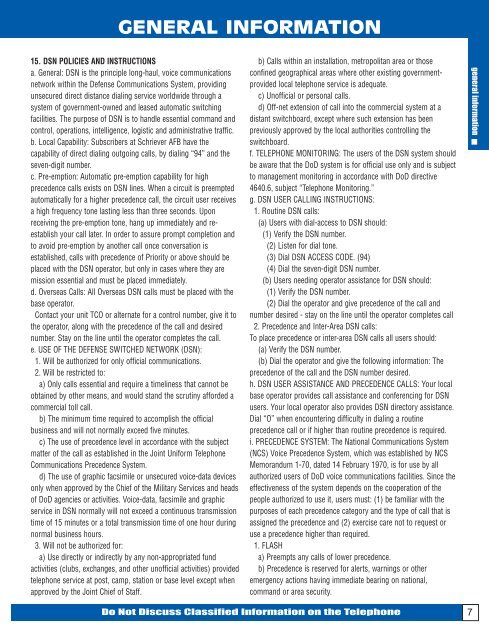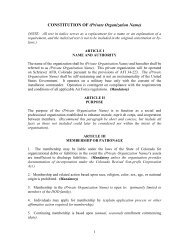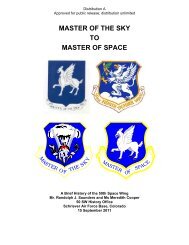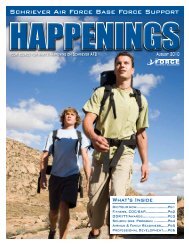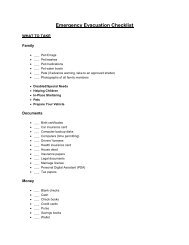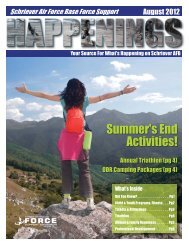310TH SPACE WING (AFRC) (310 SW) - Schriever Air Force Base
310TH SPACE WING (AFRC) (310 SW) - Schriever Air Force Base
310TH SPACE WING (AFRC) (310 SW) - Schriever Air Force Base
You also want an ePaper? Increase the reach of your titles
YUMPU automatically turns print PDFs into web optimized ePapers that Google loves.
GENERAL INFORMATION<br />
15. DSN POLICIES AND INSTRUCTIONS<br />
a. General: DSN is the principle long-haul, voice communications<br />
network within the Defense Communications System, providing<br />
unsecured direct distance dialing service worldwide through a<br />
system of government-owned and leased automatic switching<br />
facilities. The purpose of DSN is to handle essential command and<br />
control, operations, intelligence, logistic and administrative traffic.<br />
b. Local Capability: Subscribers at <strong>Schriever</strong> AFB have the<br />
capability of direct dialing outgoing calls, by dialing “94” and the<br />
seven-digit number.<br />
c. Pre-emption: Automatic pre-emption capability for high<br />
precedence calls exists on DSN lines. When a circuit is preempted<br />
automatically for a higher precedence call, the circuit user receives<br />
a high frequency tone lasting less than three seconds. Upon<br />
receiving the pre-emption tone, hang up immediately and reestablish<br />
your call later. In order to assure prompt completion and<br />
to avoid pre-emption by another call once conversation is<br />
established, calls with precedence of Priority or above should be<br />
placed with the DSN operator, but only in cases where they are<br />
mission essential and must be placed immediately.<br />
d. Overseas Calls: All Overseas DSN calls must be placed with the<br />
base operator.<br />
Contact your unit TCO or alternate for a control number, give it to<br />
the operator, along with the precedence of the call and desired<br />
number. Stay on the line until the operator completes the call.<br />
e. USE OF THE DEFENSE <strong>SW</strong>ITCHED NETWORK (DSN):<br />
1. Will be authorized for only official communications.<br />
2. Will be restricted to:<br />
a) Only calls essential and require a timeliness that cannot be<br />
obtained by other means, and would stand the scrutiny afforded a<br />
commercial toll call.<br />
b) The minimum time required to accomplish the official<br />
business and will not normally exceed five minutes.<br />
c) The use of precedence level in accordance with the subject<br />
matter of the call as established in the Joint Uniform Telephone<br />
Communications Precedence System.<br />
d) The use of graphic facsimile or unsecured voice-data devices<br />
only when approved by the Chief of the Military Services and heads<br />
of DoD agencies or activities. Voice-data, facsimile and graphic<br />
service in DSN normally will not exceed a continuous transmission<br />
time of 15 minutes or a total transmission time of one hour during<br />
normal business hours.<br />
3. Will not be authorized for:<br />
a) Use directly or indirectly by any non-appropriated fund<br />
activities (clubs, exchanges, and other unofficial activities) provided<br />
telephone service at post, camp, station or base level except when<br />
approved by the Joint Chief of Staff.<br />
b) Calls within an installation, metropolitan area or those<br />
confined geographical areas where other existing governmentprovided<br />
local telephone service is adequate.<br />
c) Unofficial or personal calls.<br />
d) Off-net extension of call into the commercial system at a<br />
distant switchboard, except where such extension has been<br />
previously approved by the local authorities controlling the<br />
switchboard.<br />
f. TELEPHONE MONITORING: The users of the DSN system should<br />
be aware that the DoD system is for official use only and is subject<br />
to management monitoring in accordance with DoD directive<br />
4640.6, subject “Telephone Monitoring.”<br />
g. DSN USER CALLING INSTRUCTIONS:<br />
1. Routine DSN calls:<br />
(a) Users with dial-access to DSN should:<br />
(1) Verify the DSN number.<br />
(2) Listen for dial tone.<br />
(3) Dial DSN ACCESS CODE. (94)<br />
(4) Dial the seven-digit DSN number.<br />
(b) Users needing operator assistance for DSN should:<br />
(1) Verify the DSN number.<br />
(2) Dial the operator and give precedence of the call and<br />
number desired - stay on the line until the operator completes call<br />
2. Precedence and Inter-Area DSN calls:<br />
To place precedence or inter-area DSN calls all users should:<br />
(a) Verify the DSN number.<br />
(b) Dial the operator and give the following information: The<br />
precedence of the call and the DSN number desired.<br />
h. DSN USER ASSISTANCE AND PRECEDENCE CALLS: Your local<br />
base operator provides call assistance and conferencing for DSN<br />
users. Your local operator also provides DSN directory assistance.<br />
Dial “O” when encountering difficulty in dialing a routine<br />
precedence call or if higher than routine precedence is required.<br />
i. PRECEDENCE SYSTEM: The National Communications System<br />
(NCS) Voice Precedence System, which was established by NCS<br />
Memorandum 1-70, dated 14 February 1970, is for use by all<br />
authorized users of DoD voice communications facilities. Since the<br />
effectiveness of the system depends on the cooperation of the<br />
people authorized to use it, users must: (1) be familiar with the<br />
purposes of each precedence category and the type of call that is<br />
assigned the precedence and (2) exercise care not to request or<br />
use a precedence higher than required.<br />
1. FLASH<br />
a) Preempts any calls of lower precedence.<br />
b) Precedence is reserved for alerts, warnings or other<br />
emergency actions having immediate bearing on national,<br />
command or area security.<br />
Do Not Discuss Classified Information on the Telephone 7<br />
general information


